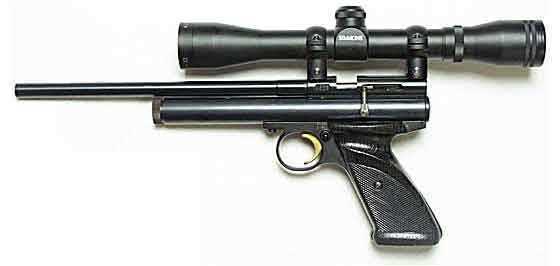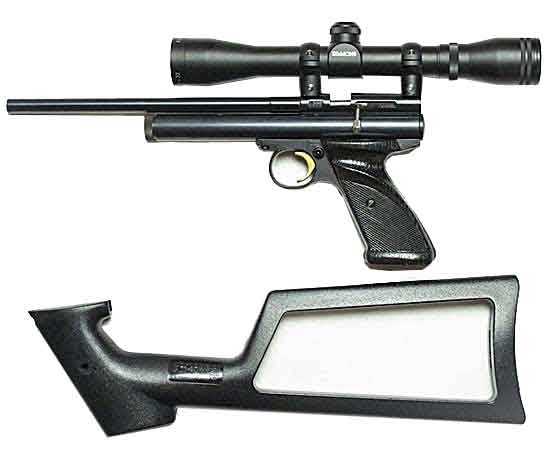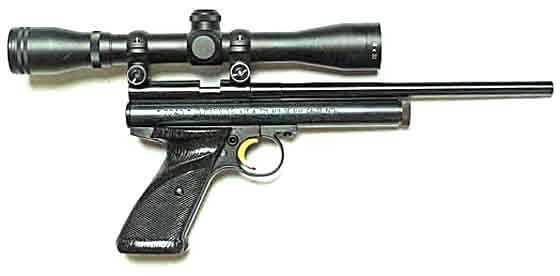by B.B. Pelletier
Test data and photos by Earl “Mac” McDonald
Back in the 1990s, Dennis Quackenbush made a nice part of his living by modifying single-shot pistols from Crosman. In those days, there weren’t as many places to buy aftermarket parts, and Crosman didn’t have a custom shop. In fact, when Dennis and I were seated with Crosman’s CEO at an NRA Airgun Breakfast at the 2001 NRA Annual Meetings and Exhibits in Kansas City, Missouri, we introduced ourselves and he asked both of us what we did. Dennis told him that he made his living modifying Crosman single-shot pistols. “You sell them (the SSP 250) for $39 and I modify them for $125. I can’t keep up with all the work!”
To say the man was stunned is an understatement. I don’t think he believed Dennis, because he restated what Dennis had said, “You mean people pay you $125 to modify a gun that sells for $39?” You could hear the disbelief in his voice.
That man didn’t remain at the reins much longer. And his replacement, Ken D’Arcy, instituted the Crosman Custom Shop a few years after he stepped in. But that did not diminish the number of aftermarket places that modify Crosman airguns and make parts for owners to install. If anything, the number of places increased, though I would not say that it was in response to the Crosman Custom Shop starting up. But it was and still is a direct result of the openness of the Crosman Corporation toward their customers, by providing parts and information that support their guns.
For several years, one of the most popular modifications Dennis made was a steel breech for the Crosman 2240 single-shot pistol. Not only is it stronger and more rigid, it also allows for the installation of a scope — something that most home tinkerers will want to do. And Dennis switched the bolt handle to the left side for right-handed shooters, because they want to continue to hold onto the pistol while they load it. People who don’t shoot these pistols don’t understand that desire, but it only take 15 minutes with one and you understand completely. That one change may have been his greatest contribution, because it showed everyone what a little thought can do to enhance the operation of an inexpensive airgun!
Many of the handguns Dennis built on Crosman frames are righteous thumpers, with power levels far beyond anything Crosman ever envisioned. Dennis has made several guns on this 2240 frame that achieved 100 foot-pounds of energy at the muzzle, and I’ve personally witnessed one that produced 300 foot-pounds. So, like the modern AR, there’s no limit to what you can do with one of these flexible air pistols.
But in this report, we’re going to look at something a little closer to the original gun. It’s a .25-caliber pistol that has the steel receiver from Dennis and a 10.5-inch barrel that he rifled. In terms of power, it’s been left pretty close to original; so it gets a decent number of shots. Because of the large caliber, they don’t go very fast.

The Quackenbush .25-caliber pistol is built on a 2240 frame. It has a steel receiver, and the bolt is on the left side for easier loading.
There are no open sights, as Dennis envisioned owners would want to scope the gun. The receiver has an 11mm dovetail cut into the top. Since the frame is from a 2240, it readily accepts an add-on carbine stock that so many shooters seem to prefer. Certainly, when you put a heavy rifle scope on the pistol, the stock is the best way to go!
Mac reports that the pull length with the carbine stock is 16.3 inches, but the angle of the grip makes it feel shorter. He says it fits him well, and he usually likes a rifle with a pull length of 13 inches. I looked at the pictures he sent and see that the scope hangs back behind the receiver on this gun. That may be why the long pull doesn’t feel so bad. Also, the gun is very light, at only 48 oz. in the scoped pistol configuration, so there’s not a lot of weight hanging out front. The shoulder stock adds another 13 oz.

The optional shoulder stock is something nearly all pistol owners have.
Dennis didn’t number all of the guns that he made, but partway through the production he began to put his own serial numbers on them. His last gun carried the number 850. Mac’s pistol is numbered 509.
Though Dennis no longer makes complete guns, according to his website he still does make the parts for them so owners can modify their own guns. The velocity of the .25-caliber pistol is approximately the same as the 2240 that it was modified from when shooting a 14.7-grain .22-caliber pellet.
The features of this modification are:
Steel barrel, receiver and bolt
The barrel is threaded into the receiver
The transfer port is in the breech instead of the barrel
The new steel bolt is larger than the pellet
The bolt contacts the pellet’s skirt — no probe is used
The pistol is 14 inches long without the shoulder stock, and 26 inches in the carbine configuration. The trigger-pull is a repeatable 43 oz., though some may find the trigger blade a bit too thin for comfort. The scope you see here is a cheap Simmons that Mac thinks was probably a rimfire scope at one time. It has a one-inch tube and fixed 4x magnification. The 32mm objective lens has a fixed parallax that Mac adjusted to 25 yards by turning the lens locking ring.
While many .25-caliber single-shots produce lots of muzzle energy, this isn’t one of them. Those guns are modified into PCPs, where this one is still a CO2 gun. It gives you a taste of a larger caliber without all the extra fuss and noise that a magnum blaster would have.
Mac tells me this pistol is quite accurate, and he loves the way it lobs them in. Next time, we’ll combine Parts 2 and 3 for a good look at the performance of this vintage Quackenbush airgun.

With the longer barrel and no open sights, this pistol looks slicker than the 2240 it was modified from.

Hi BB,
For years I have read that #3 Hornady shot works well in 25 cal C02 or PCPs. I wouldn’t want to try it in a springer but it would be interesting to see how it shoots in Mac’s pistol.
David Enoch
David,
I have fired buckshot from several air rifles, including one that Gary Barnes made for me and then turned into the Barnes Ranger that Edith used to compete in BR-50. The buckshot worked well, though the accuracy was only mediocre. In those days Barnes was talking about hitting Oreo cookies. No animal, he said, could hide behind an Oreo cookie.
I also used to own a black powder rifle that was designed to shoot number 4 buckshot, which is very close to .22 caliber.
B.B.
I was looking at the specs for the Evanix Semi/Auto air rifle. That rifle is crying for a 20 shot magazine. I wonder why they went with a 10 shot? It’s pricey but hey……..It’s full auto!
Mike
Mike,
There have been some changes on the specs for the Conquest, Speed & Max full-/semi-auto guns:
.177=13 rds per mag
.22=11 rds per mag
.25=10 rds per mag
Double mags are available again, and they are as follows:
.177=26 rds per mag
.22=22 rds per mag
.25=20 rds per mag
Edith
That’s an improvement. However, the double mags look like they need to be removed and reloaded into the gun to get the additional shots. They really need a high cap mag that will shoot 20 shots without switching the mag around. That would make a big difference it the sales potential of the rifle. I’ll bet an after market mag will show up if Evanix doesn’t make one.
Mike
Well, one reason might be the need to keep the revolving cylinder to a reasonable diameter. If you double the number of rounds, you may need to (nearly) double the diameter of the cylinder. Ultimately, that’s why six rounds seems to be a pretty common load (plus/minus 1) for firearms.
pete
Very true. Double the size! 🙂
Mike
B.B. & Edith,
Yes, I know that I’m your #1 cause of headaches.
Is this in the queue for a review?
/product/winchester-m14-co2-air-rifle?m=2719
Will PA be providing a link to the manual on the website?
Sorry.
kevin
Kevin,
Yes. It’s on order. We got a shipment of guns & pellets yesterday, so I’m assuming it was in the box.
Edith
Edith,
No, that Winchester didn’t come yesterday. We got a Hatsan 95 that I’m starting to test tomorrow and some kind of Gamo breakbarrel.
B.B.
Kevin,
Yes, that M14 is on order right now. I saw it and held it at the NRTA show last month and was impressed by both the look and its magazine. As soon as it comes in I will be starting the blog.
B.B.
B.B.,
Thanks. Looking forward to it. Should get lots of shots. Hope it feeds pellets well. Doesn’t look like you can scope this one. Lots of questions but I’ll be patient.
Another new gamo breakbarrel arrived at your place? Yippee.
kevin
Kevin,
I stand corrected. It’s not here, yet. The manual wasn’t available when I wrote up the gun’s product page. I just downloaded the manual from Daisy’s site & sent it to someone to upload it. I’ll read it over this week & see if I got the description right 🙂
Edith
Edith,
Thank you. I’ll keep checking the PA site.
I knew you were talented but writing up a description of a new gun without the gun or manual is over the top.
kevin
It’s like you read my mind!!! I wanted to ask about it all week-end but every time I made a post I forgot about it!
The wood imitation plastic is a little bit of a turn off but the rest looks so nice!
Daisy just made (or I just found out about it) a new website for their line of Winchester products:
http://www.winchesterairrifles.com/Products/M14.aspx
J-F
B.B.
Time to boast!
http://i46.tinypic.com/2ufww44.jpg
Assembled everything together for the first time. Surprisingly, everything fits quite easily and works as intended. Main lever is not fully closed to show the hook, long screw instead of a proper trigger, but nevertheless, the “engine” is here.
A good point to take some day off. Tomorrow I’m leaving for Cologne, Rhine valley and maybe some Netherlands or Belgium, so a week of dolce far niente and beautiful landscapes fill get me back on my feet. And by that time, I hope, receiver will be ready 😉
duskwight
Wow!
duskwight — you airgun builder! You have done it!
It looks impressive so far.
Have a wonderful vacation.
B.B.
Otlichno! Wonderful! Makes me wish I could pick it up and feel it…!
/Dave
Congratulations! Mazel Tov! Eureka!
It is hard to communicate how gratifying it is to see your dream come to fruition. I am impressed and I salute you sir.
Perhaps one day if I am fortunate enough, I just might be able to purchase a Duskwhiscombe.
Beautiful – a work of art!
Fred DPRoNJ
duskwight,
Very impressive. You should be proud. I know you’ve been working diligently and am happy for your progress.
kevin
You have my utmost respect……it looks excellent! What a great accomplishment.I would LOVE to shoot it! I know it will perform as good as my JW80.How many strokes to set the pistons?? I am very excited for you on this journey.Enjoy your trip,it sounds wonderful as well.
Frank,
I think he said his rifle is only cocked one time.
B.B.
Hi BB
This looks very interesting, but I think it’ll probably be restricted to a very small niche market. I’m not certain about the increase to .25 calibre whilst retaining the same powerplant. I doubt whether it will go much faster than 350 to 360 FPS and this will make it an expensive plinker using expensive ammo, but this is just me and I’m sure I’m missing the point. I have to admit that I really liked the Quakerbush .308; that one seemed to be really useful as a hunting rifle.
Looking at really affordable handguns, I came across the Benjamin Trail NP Air Pistol. This really looks like something special at an unbelievable price. What about a test on this one, please!
Regards
Vasco
Vasco,
I have a Benjamin Trail on order and as soon as it comes I will test it for you.
B.B.
I guess I ought to comment today,considering I went NUTS for Dennis’s guns a couple years ago……and haven’t come back yet! They are everything I ever wished for in a compact,accurate powerhouse!
To be clear,all the ones I have are HPA only,except for one pistol (16″ long) with a Discovery tube
that Walter Glover built using a Disco valve,pinned in with screws for safety.It works nicely for Co2
or HPA.
Dennis made “Outlaw” pistols…..that use the 2240 grip frame,and came in .22,.25,.308,357,& I believe .452…..although I don’t have the .457.My .25s are set up as carbines,and shoot Kings at 930-950 fps very accurately.Half inch 5 shot groups at 50 yards are common.
Right now Lloyd Sykes has a .25 rifle,the “Knave” & a 9mm pistol “outlaw” to play with on loan.I figured a guy with his vision and talent is bound to dream up something excellent with Dennis’ guns for a muse.
I look foreward to pts. 2&3……I remember reading Tom’s reviews repeatedly prior to my campaign to buy every DAQ I could afford.Now I just need a Shoebox compressor and a gross of JSB Kings in .25!
A .375 cal one just sold on the CAF for a bit under 350$.
It looks a lot like this one but with the 2250 plastic part under the tube where the CO2 powerlet goes, he claimed 15 shots from one powerlet.
It sold in minutes, if he had a half dozen for sale they all would have sold before the end of the day… at 350$ each.
That was actually a pretty good price at $350…..the interest outweighs supply fairly consistently.
I wish I could machine breeches……I understand it is NOT real easy.